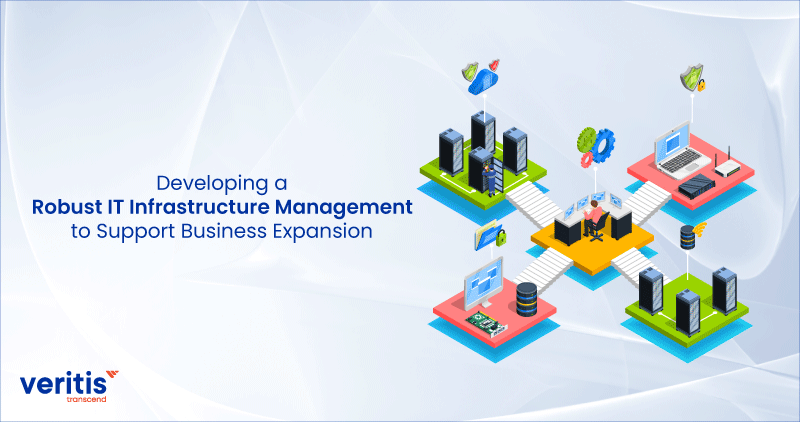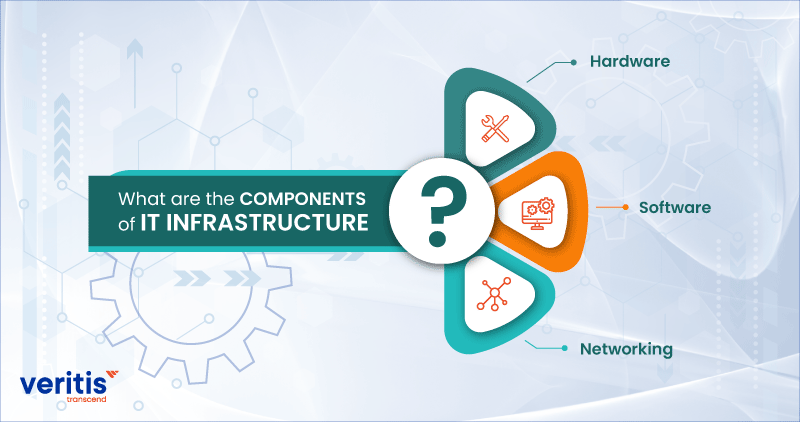
Having a robust and dependable plan to manage your IT infrastructure is important for businesses in today’s digital age. No matter your industry, many of your important tasks and operations depend on your IT systems. With reliable software, you can ensure all your processes and applications work together smoothly to achieve the desired results.
This will help you make decisions faster and promote innovation. You must maintain a reliable IT infrastructure monitoring platform to ensure smooth business operations and goal achievement. This tool is essential for monitoring your IT systems and addressing any issues promptly.
Efficiency, productivity, performance, and security are essential for a successful business. It’s important to prioritize these aspects and adapt to market trends to stay competitive. IT infrastructure services play a crucial role in achieving these goals.
Businesses now want their IT infrastructure solutions to be strong and flexible, able to adapt to technology changes without high costs. The main aim of mission-critical IT infrastructure should be to support broader business goals while embracing new technologies.
Successful businesses often aim to expand into new regions or countries. In a recent survey conducted by G-Core and Censuswide, a British research agency, 78% of game company respondents expressed plans to enter new markets. However, venturing into new markets comes with its own set of challenges. Before expanding digitally to reach new customers, it is crucial to consider your systems’ technical, legal, and financial aspects.
We will explore what IT infrastructure is and how it can contribute to the growth of your business. Let’s also know about the important parts of a successful IT strategy and why they are crucial for your business success. Let’s explore more about IT infrastructure!
What is IT Infrastructure?
IT infrastructure refers to the components used to operate and manage enterprise IT environments. These components can deploy in a cloud computing system or within the organization’s facilities.
Components include hardware, software, networking, operating system, and data storage. They deliver IT services and solutions. IT infrastructure products can be downloadable software or online solutions like IaaS.
What are the Components of IT Infrastructure?

Components of IT infrastructure include:
1) Hardware
This includes servers, data centers, computers, routers, switches, and other equipment. The facilities that house and support data centers are also part of the infrastructure.
2) Software
It refers to the applications used by the business, such as content management systems, web servers, and operating systems like Linux. The operating system manages remote infrastructure management, system resources, hardware, and connections between software and physical resources.
3) Networking
It involves interconnected components facilitating network operations and communication between internal and external systems. This includes internet connectivity, network enablement, firewalls, security measures, routers, switches, and cables.
Useful link: Exploring the Benefits of Infrastructure as Code (IaC) in IT Operations
Types of IT Infrastructure

1) Traditional Infrastructure
In a traditional infrastructure, businesses manage and own components such as data centers and storage within their facilities. It is expensive to maintain and requires powerful hardware, such as servers, power, and physical space.
2) Cloud Infrastructure
Cloud infrastructure refers to the necessary components and resources used in cloud computing.
You have two options:
- Create a private cloud by building it yourself with dedicated resources.
- Use a public cloud by paying for cloud infrastructure from providers like Alibaba, Amazon, Google, IBM, or Microsoft.
To create a hybrid cloud, you can combine multiple clouds and manage workloads for better flexibility and control.
3) Hyperconverged Infrastructure
Hyperconverged managed infrastructure services let you manage your computing, network, and data storage resources from one place. It combines software-defined computing and data storage, so you can easily handle modern workloads and scale using regular hardware.
The Role of an IT Infrastructure in Supporting Business Growth

An effective IT infrastructure is essential for business growth. It plays a crucial role in improving business performance. Let’s explore how a well-functioning IT infrastructure supports business success.
1) Faster Time to Market
For a company to remain competitive in today’s market, it must experience business growth. This growth relies on swiftly developing and launching new products and infrastructure technology services. To enable this, having an efficient IT infrastructure is crucial. By improving processes, enhancing operational efficiency, and ensuring the right IT infrastructure solutions, firms can bring their offerings to the market faster.
Furthermore, efficient IT infrastructure solutions contribute to cost savings in development and release expenses. This means businesses can reduce their costs while still achieving growth. Therefore, efficient IT infrastructure solutions drive business growth and success.
2) Minimizes Business Disruptions
Downtime is a big problem for businesses. It stops work and frustrates customers. Fully managed infrastructure services are important to avoid this. Investing in reliable hardware and software helps prevent problems and reduces their impact. Good IT infrastructure services also warn of potential issues so that action can take in advance.
Having backup systems is crucial. If one fails, another can take its place. This ensures the business can keep running, even if one system has a problem. Scalability is also important. As the business grows, the IT infrastructure services should grow too. This allows the company to keep running smoothly as it takes on more challenges.
3) Allows Real-Time Data Gathering
Any successful business relies on efficient data gathering and analysis to make informed decisions. In fact, according to an IDC report, big data and analytics spending is expected to reach $307.52 billion in 2023. This represents a significant increase from the $215 billion spent in 2021, underscoring the growing importance of big data and analytics in business.
The global big data and analytics market is expected to grow at a CAGR of 13.5% from 2023 to 2030. Several factors drive this growth, including the increasing availability of data, the growing adoption of cloud infrastructure management, and the rising demand for insights from data.
As the big data and analytics market grows, businesses must invest in the right technologies and skills to stay ahead of the competition. By doing so, they can use data to make better decisions, improve their operations, and deliver better customer experiences.
In the past, gathering and analyzing data was hard because it took a long time to collect and process information. But now, with modern IT infrastructure managed services, businesses can gather real-time information that can be used to make decisions right away. This is important in industries where things change quickly, and businesses must make decisions quickly to stay ahead of the competition.
Investing in fast and reliable hardware can help businesses quickly get the necessary information. Efficient infrastructure technology services can also help reduce the data loss risk by providing redundancy and backup options. Companies can gain a competitive benefit by investing in an efficient IT infrastructure.
Here are some of the key points:
- Modern IT infrastructure can help businesses gather real-time data that can be used to make decisions immediately.
- This is important in industries where things change quickly.
- Investing in fast and reliable hardware can help businesses quickly get the necessary information.
- An efficient technology infrastructure can help to reduce the risk of data loss.
- Businesses can gain a competitive benefit by investing in an efficient IT infrastructure.
4) Boosts Employee Productivity
A reliable IT infrastructure allows employees to work faster and more efficiently. They have access to up-to-date software and hardware, which improves communication and productivity. This means they can accomplish more tasks in less time.
Moreover, a strong IT infrastructure managed services reduces stress and boosts morale. Employees who struggle with outdated or ineffective infrastructure technology services feel frustrated and demotivated. On the other hand, when employees have the necessary resources to perform their jobs well, they are more comfortable and engaged in their work.
5) Assists in Improving Customer Service
A good IT infrastructure managed services can help businesses improve their customer service.
This is because a good IT infrastructure can:
- Make it easier for customers to contact businesses. This can be done by offering multiple channels for customer contact, such as phone, email, and live chat.
- Help businesses track customer interactions. This can guide businesses to identify trends and improve their customer service strategies.
- Provide businesses with the tools to resolve customer issues quickly and efficiently. This can include access to knowledge bases, customer relationship management (CRM) software, and other tools.
Overall, a good IT infrastructure can help businesses to provide better customer service by making it easier for customers to contact businesses, tracking customer interactions, and providing businesses with the tools they need to resolve customer issues efficiently and quickly.
Here are some instances of how good IT infrastructure can improve customer service:
- A company that uses a cloud-based CRM system can give customer service representatives access to customer information from anywhere, which can help them to resolve customer issues more quickly.
- A company that uses a chatbot can provide customers with 24/7 support, which can help to lessen wait times and improve customer satisfaction.
- A knowledge base allows a company to offer customers self-service solutions to their inquiries. This helps customer service representatives prioritize more complicated matters and provide better assistance.
Businesses can give their customers the best possible experience by investing in good IT infrastructure management services.
Useful link: Cloud Infrastructure Automation: The Imperative for Cloud Success!
Guidelines for Developing an Agile and Robust IT Infrastructure Management
1) Use a Combination of Cloud and On-Premises Systems
Using cloud infrastructure management and on-premises systems provides flexibility to leverage their strengths. Cloud infrastructure management can scale and adapt easily, while on-premises systems offer enhanced security and low-latency capabilities.
2) Use Microservices Instead of Monolithic Architecture
Microservices are a more agile and scalable architecture than monolithic applications. This is because microservices can be updated and scaled independently, making changing your IT infrastructure management services easier.
3) Keep Data Backups
This is essential for businesses, as data loss can be a major setback. Backups should be stored off-site securely to ensure they are available during a disaster.
4) Ensure Interoperability Between Systems
This will allow you to share data quickly and easily between different systems. This can achieve through the use of standards-based APIs or by using a middleware solution.
5) Implement Security at All Levels
This is essential for businesses, as security is a major concern regarding IT infrastructure management services. Security should be implemented at all levels of your IT infrastructure, from the network to the application level.
Following these tips, you can build agile and robust IT infrastructure management services to help your business succeed.
Conclusion
Reliable IT infrastructure management is important for a successful digital transformation. This includes strong networks, security measures, backup plans, and data management. If you need assistance, Veritis, the Stevie Award winner, offers IT Infrastructure management services to support your organization’s requirements.
With our expertise in data management, analytics, strategy implementation, workflow management, and cloud computing, we can help you build a robust IT infrastructure that adds value to your business. Contact Veritis for IT Infrastructure consulting.
Got Questions? Schedule A Call
Also Read:
- Why Is Remote Infrastructure Management Important for Businesses?
- Cloud Infrastructure Automation: The Imperative for Cloud Success!
- Why Is Remote Infrastructure Management Important for Businesses?
- Cloud Vs On-Premise: IT Infrastructure Model of Your Choice?
- IT Infrastructure Automation for Financial Operations
- IT Infrastructure in Mining Industry – Ease Business with Seamless Server Provisioning